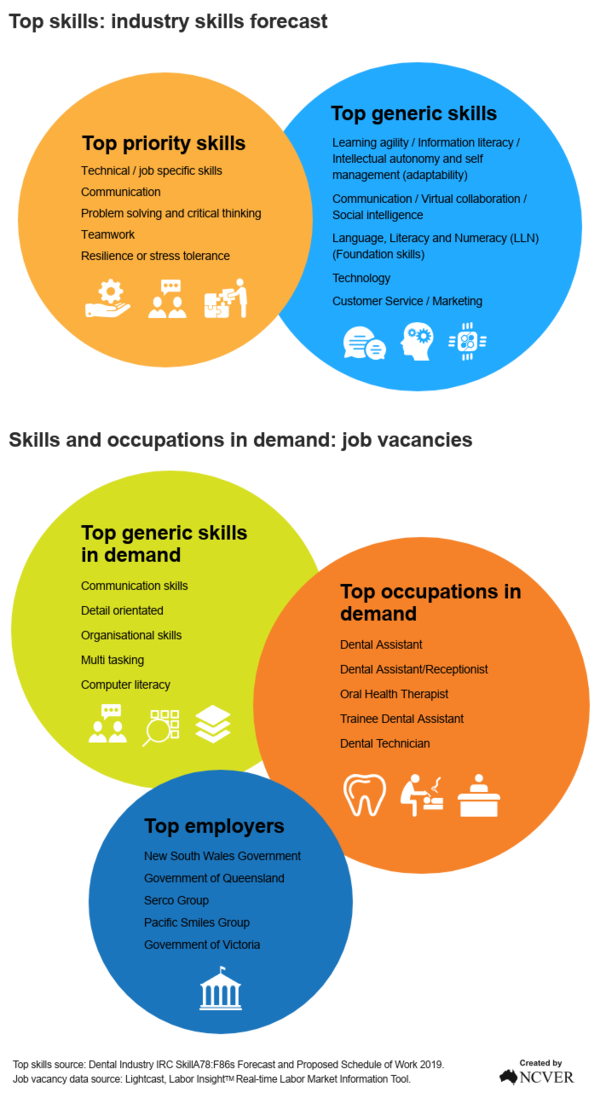
Industry insights on skills needs
The Dental IRC's Skills Forecast – 2020 Update (hereafter the 2020 Annual Update) was the most recently published industry skills forecast by the IRC, as of September 2022. It identified the top five short-to-medium term skills considered critical for the sector as technical job specific skills, communication, problem solving or critical thinking, teamwork and resilience or stress tolerance.
According to the job vacancy data, the top requested skills by employers in the sector were communication skills and detail orientated. The most advertised occupations were Dental Assistant, followed by Dental Assistant/Receptionist. The top employers were the New South Wales Government, followed by the Government of Queensland.
COVID-19 has impacted the Dental sector, as well as the respective job roles in different ways (further information below). The other main challenges faced by the dental services workforce continue to be those reported in the Dental IRC’s 2019 Skills Forecast, which include advances in technology, access to a skilled workforce with practical experience and the lack of career progression. Further information about the impact of COVID-19 is below
Advances in technology
Technology continues to be a key area of focus in the skills required by dental assistants and dental technicians, according to 2020 Annual Update. Increased use of technology with new equipment and new practices requires a flexible workforce able to learn how to operate new equipment and adopt new procedures. Digital and computing skills are also required in day-to-day office administration and clerical roles and help to support the quality of service provided to patients. Restrictions on dental practices during the COVID-19 pandemic have also encouraged greater use of digital photography and tele-dentistry.
The impact of COVID-19 has generated the emergence of tele-dentistry options locally and internationally, including online screening, treatment planning and referral. Authors of Telehealth Coaching in Oral Healthcare argue Dental Assistants with a Certificate IV in Dental Assisting [Oral Health Promotion] can deliver appropriate guidance and support to patients for a low-cost base oral health coaching program via video or audio teleconferencing. As such, they suggest a cost-benefit analysis of a telehealth oral health coaching program, delivered by trained Dental Assistants, is warranted.
Staff shortages, especially in regional areas
The 2020 Annual Update reports some employers in the sector are experiencing difficulties in hiring appropriate staff due to a shortage of skilled workers, limited applicants and a lack of existing workers being skilled up. Access to a skilled workforce continues to be challenging, particularly in regional and rural areas. Evidence of this shortage in regional areas can be seen in that some dental services job roles are listed by the Australian Government as Skilled Occupations that would enable a person to migrate to Australia through the Regional Sponsor Migration Scheme, or as a temporary migrant provided the employment occurs in regional Australia. Job roles listed include dental prosthetist and dental technician.
The level of practical experience required to complete a qualification through a work placement may be difficult to achieve, particularly in regional and rural areas, where access to workplaces providing opportunities to apply skills and knowledge in a practical setting is limited. This may lead to using simulated experiences to build skills and knowledge, and then determining whether this is sufficient prior to completing a qualification and being able to undertake this work. However, the preference is for experience with live patients using work placement opportunities.
Separately, there are significant inequalities in oral health status between Aboriginal and non-Aboriginal children in Australia, particularly where the children have insufficient access to various forms of fluoride. The study Aboriginal Dental Assistants applying fluoride varnish in regional, rural and remote primary schools in New South Wales (NSW) found that Aboriginal Dental Assistants who are trained can safely and effectively apply fluoride varnish in a school setting with remote supervision. The study demonstrated the program can be scaled at the state level in NSW, indicating it could provide the basis for a nationally consistent program. As such, the Poche Centre as part of its scale-up planning for the Fluoride Varnish Program is examining the feasibility of including the apply fluoride varnish skillset in its existing Aboriginal Dental Assistant Scholarship Program.
Lack of career progression
According to the 2020 Annual Update, lack of career progression was an area of concern and the review of the Certificate III and Certificate IV in Dental Assisting sought to provide greater demarcation in skill levels between these qualifications. This would provide opportunities for further development for people interested in progressing to the higher qualification. Access to training linked to clear career pathways will be beneficial to ensure Dental Assistants and Technicians have opportunities to enhance their skills and grow within the dental services sector. The project to update the Packaging Rules of the two qualifications and two skill sets, and to update and develop Units of Competency to align to the changing duties of existing and future job roles of all dental staff was approved in early 2021.


